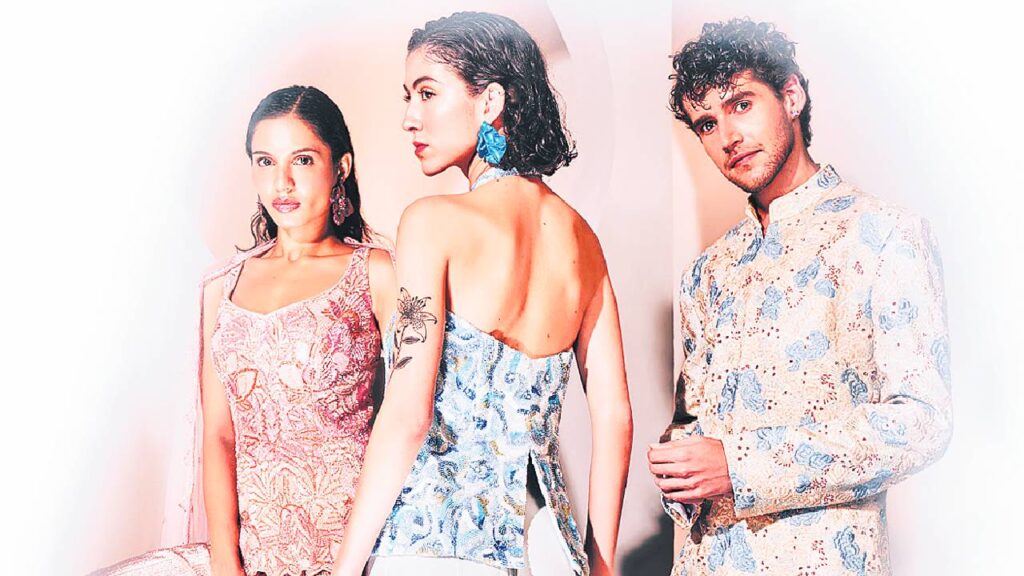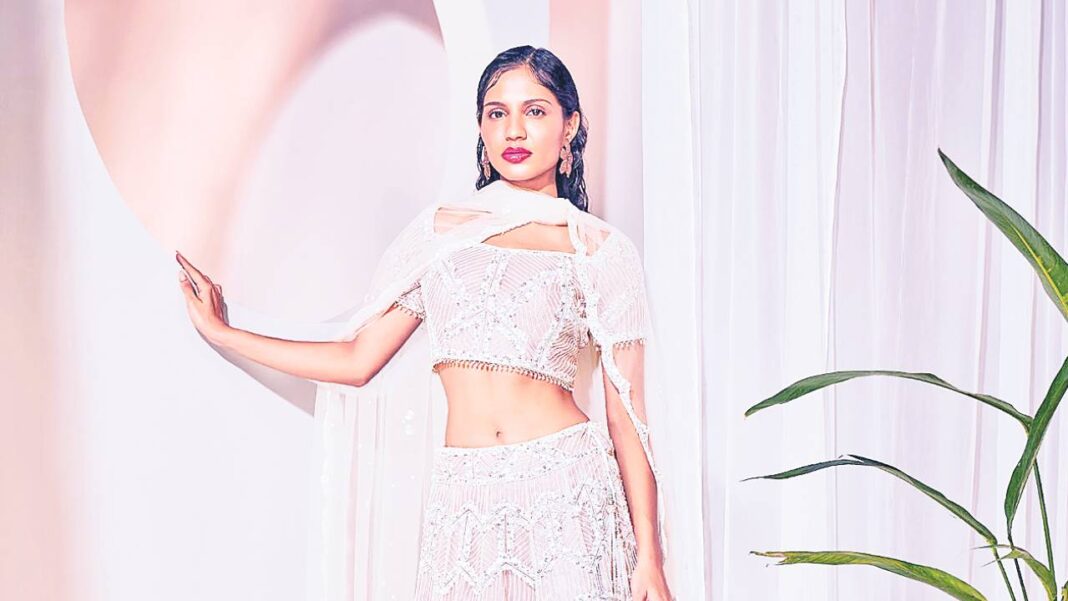PNS|HYDERABAD
An important turning point in the history of couture is reached at Azura when the renowned Sangeeta Kilachand, who is renowned for her iconic heritage designs, teams up with her son Arjuun Kilachand, a trailblazer in contemporary menswear.
The exquisite capsule collection of finely crafted pieces that reinvent tradition for the modern era is the result of this mother-son duo. Sangeeta Kilachand created the collection, which includes a sophisticated selection of women’s sarees, kurtas, belted tunics, slacks and jackets. Arjuun has produced a line of matching kurtas, bundis and achkans for men. These pieces combine to form a multipurpose wardrobe that incorporates both tradition and contemporary style!

Sangeeta expands her creative horizons while adhering to the classic workmanship that distinguishes her reputation with it, her first venture into couture with modern inspirations.
The spirit of the deep blue sea is captured by it through elaborate embellishments and elegant silhouettes, which are rooted in its fluid strength and mystery. The sea’s timeless charm is echoed by pearls, floral designs conjure its poetic whispers and sequins glitter like sunlight dancing over waves. Reminiscent of bountiful aquatic worlds, the collection’s primary colour scheme consists of colours of brilliant yellow, calm blues, startling reds and soothing whites.
India’s renowned karigars are honoured in this collection, which highlights the artistry and dedication of craftspeople whose unmatched skill continues to influence fashion worldwide. Sangeeta Kilachand, the founder of Sangeeta Kilachand Heritage Clothing and Arjuun Kilachand, the founder and CEO of Arjun Kilachand, will tell us more about the collection and what comes next.
Excerpts from the interview
What aspects of combining two creative visions with wildly disparate sartorial languages were the most rewarding and challenging?
Sangeeta: Letting up strict definitions of tradition was the hardest part. While Arjuun offers a bolder, more minimalist, more structured look, my work has always been firmly grounded in classical design and handmade craftsmanship. We both needed to be very open-minded and trusting in order to merge these. However, the payoff has been just as potent—we produced something that neither of us could have done on our own.
What drove you to venture into contemporary couture now?
Sangeeta: It was a very personal development. I’ve always thought that tradition is designed to develop rather than remain stagnant. Working with Arjuun allowed me to experiment with modern forms without sacrificing the essential principles of my work. Handcrafted details, elaborate needlework and artisanal excellence—the essence of my hallmark style—remain intact. Now, things are represented differently, with lighter constructions, sleeker designs and a more flowing style that appeals to today’s Indian woman who lives all over the world.
How has your perspective on heritage and its applicability in the menswear industry changed as a result of working with your mother, who is so steeped in classical design?
Arjuun: Tradition is a resource to be reinterpreted, not something to revolt against, as I learned from working with my mother. Her love of handicrafts and storytelling via clothing inspired me to go back to what I used to think of as “old-world.” I now think it’s really beneficial to incorporate classical components into contemporary frameworks. There are echoes of royal elegance in but it has been reinterpreted for a man who appreciates both tradition and uniqueness. I feel stronger and more confident in my ability to translate that into menswear because of this collection.
How did the emotional and symbolic depths of the ocean affect the clothing’s movement, structure and mood beyond its visual motifs?
Arjuun: I believe that the ocean is eternal because it is strong, feminine, enigmatic and always changing. Through each piece’s structure and drape, it embodies that spirit. Light-catching decorations, weightless textiles, and flowing silhouettes will all be seen. On an emotional level, it stands for continuity—of memory, of craft, of culture. Our clothing should flow with the wearer, not constrict them, like the sea does. Each ensemble has a subtle elegance that reflects the calm and depth of the sea.
Indian Karigars are a community that is sometimes left out of popular fashion narratives, yet the collection honours them. How did you make sure their work was genuinely at the heart of its story rather than just being displayed?
Sangeeta: Our karigars are the essence of this collection; they are more than simply the artisans. Arjuun and I had made it clear from the beginning that it would highlight their heritage. Along with them, we co-created rather than merely commissioning stuff. Many design choices were influenced by what our craftspeople could create with traditional methods. In every thread and needlework, their names, their histories, and their local skills have been honoured. Their genius in its purest, most eminent form is celebrated in it.
How did you strike a balance between practicality and luxury when designing a collection that is both anchored in tradition and intended for modern celebration?
Arjuun: It all came down to careful moderation. While heritage crafts tend to be maximalist, we wanted it to have some breathing room. We added opulent details in tasteful, contemporary ways—fabrics that feel as beautiful as they look, shapes that flow and embellishments that accentuate rather than overpower. In addition to being wearable, breathable and multipurpose, each piece is celebratory. Because of this harmony, it is still relevant to modern women who desire style without going overboard.
Do you see it as a one-time tribute or the start of a more thorough investigation into legacy partnerships—possibly even as a model for the intergenerational evolution of Indian couture?
Sangeeta: Azura, in my opinion, is the start of a longer discussion. In the fashion industry, legacy is frequently perceived as something static that is passed on unchanged; yet, as a result of this collaboration, we have learned that legacy can be dynamic, fluid and cooperative. Exploring this junction of age, viewpoint and design further would be a pleasure. It would be a stunning addition to the development of Indian couture if it were to serve as a model for upcoming legacy partnerships.
What does timelessness mean to each of you in this day of rapid fashion and digital fatigue?
Arjuun: Timelessness, in my opinion, is when something made with soul, integrity and purpose endures beyond fads. Emotional longevity is more important than mere beauty. It is a subdued protest against today’s disposable fashion. Every item of clothing is designed to be worn, cherished and handed down. I hope it serves as a reminder to the younger generation that fashion can still be poetic, meaningful and personal while embracing the present.




